Make your landscape designs fun. PUFFER FISH® Hydrangea paniculata is like a BOBO® Hydrangea, but on steroids. Like Bobo, every inch of the plant is covered in billowy white blooms, but the plant is larger and the flower heads are much larger. It’s so lovable, you will be compelled to hug it. Even as the white flowers age to green, new flowers continue emerge at the tip. A bit like a fish statue spitting water into a fountain. Never floppy, the strong stems hold up the big blooms in the container and in the garden.






Six Shrubs With Fantastic Fall Foliage
I would have thought, off the top of my head, that were are lot of shrub species that had fantastic fall color, but when I drove our trial fields searching, I was dismayed that only a limited number of species really stood out with bright autumn hues. Of course everyone thinks of burning bush as the quintessential fall color shrub, but there has to be more. What else is there to use?
With a bit of thought I came up with a list of six outstanding shrubs that can add fantastic fall color to your landscape. They’re in no particular order, but they’re all excellent plants that are worthy of a place in your yard, nursery or landscape design. Each has its own unique hue of fall foliage color from blends of bright orange to bold purplish-reds. And unlike Euonymus alatus, they’re all North American natives.

Fothergilla has always been appreciated for its spectacular autumn color, but Legend of the Fall® fothergilla sets a new standard for the species with brilliant, glowing hues of orange, yellow, and red. Spring brings a crop of fragrant white flowers. This plant was also selected for its improved production performance, a boon since this plant will surely be in high demand by landscapers and garden designers. USDA Zone 5 – 9 (-20°F/-28.9°C)
Exposure: Full sun, part sun
Height: 4 – 5′
Width: 4 – 5′
Bloom Time: Spring
Flower Color: White
2. LOW SCAPE MOUND® Aronia melanocarpa

As cute as a button yet tough as nails, Low Scape Mound® aronia is an innovative dwarf selection that may be the closest thing yet to a perfect landscape plant. Adaptable to most any soil, this versatile little black chokeberry offers dark glossy foliage, loads of white flowers in spring, black summer fruit, and intense red foliage in autumn. Ideal for low maintenance mass plantings; think of it as Rhus ‘Gro Lo’ with multi-season appeal. Developed by Dr. Mark Brand of the University of Connecticut. Low Scape Mound aronia is the 2019 Landscape Shrub of the Year. Winner of the Boskoop Royal Horticultural Society Silver Medal
USDA Zone 3 – 9 (-40°F/-40°C)
Exposure: Full sun, Part sun
Height: 1 – 2′
Width: 2′
Bloom Time: Spring
Flower Color: White
3. KODIAK ORANGE® Diervilla

Another eco-friendly alternative to burning bush, Kodiak® Orange diervilla pushes fall color to the limits with its transformation to fire embers orange. In the spring and summer new growth emerges a showy russet-orange which is accompanied by bright yellow flowers in summer. But late summer and fall are the real show when the entire shrub turns bright citrus orange. This easy growing, vigorous North American native is unbothered by pests or diseases. Diervilla is one of the most adaptable landscape plants you can grow. You” find it growing in dry shade on the shores of Lake Superior, south on the red clay soils of Georgia. Sometimes known as bush honeysuckle, which is just pain stupid as well as a misnomer, so just call it diervilla as the common name. Developed by Garden Genetics, Kodiak Orange won the Boskoop Royal Horticultural Society Silver Medal.
USDA Zone 4 – 7 (-30°F/-34°C)
Exposure: Full sun, Part sun, Shade
Height: 3 – 4′
Width: 3 – 4′
Bloom Time: Summer
Flower Color: Yellow
Foliage Color: Orange
4. SCENTLANDIA® Itea virginica

Fabulously fragrant. Sweetspire is beloved for so many reasons: it’s native, shade tolerant, deer resistant, has handsome foliage, amazing fall color, very showy flowers, and of course, delicious fragrance. So how could Scentlandia® sweetspire improve on the classic? Better hardiness, and better fragrance. It has the best fragrance of any Itea I’ve ever encountered. Year after year you’ll get great fall color, along with a compact, refined habit. Winner of the Boskoop Royal Horticultural Society Silver Medal. I named it in honor of one of my favorite TV shows.
USDA Zone 5 – 9 (-20°F/-28.9°C)
Exposure: Full sun, Part sun, Shade
Height: 2 – 3′
Width: 2 – 3′
Bloom Time: Early summer
Flower Color: White
Foliage Color: Green
5. SKY DEW GOLD® Vaccinium corymbosum

Bright yellow foliage is the back drop for tasty summer blueberries. Things get even more interesting as the summer nights start to cool and the golden foliage start taking on rich hues of orange and red. The transformation is simply thrilling; seeing something so colorful and cheerful puts a smile on my face.
USDA Zone 4 – 8 (-30°F/-34.4°C)
Exposure: Full sun
Height: 2 – 4′
Width; 3 – 4′
Bloom Time: Late spring
Flower Color: White
Foliage Color Chartreuse, Orange
6. GATSBY PINK® Hydrangea quercifolia

Just as The Great Gatsby is a classic of American literature, H. quercifolia is a classic North American native hydrangea. Long prized by savvy gardeners for it’s flowers and fall color, this sophisticated shrub deserves a wider market. Gatsby Pink is a remarkable oakleaf selection from Powell Gardens of Kingsville, MO. It boasts big showy lacecap blooms that quickly transform from pure white to a delightful pink.The dark green foliage turns mahogany-red in autumn. It also reblooms a bit as well.
USDA Zone 5 – 9 (-20°F/-28.9°C)
Exposure: Full sun, Part sun
Height: 6 – 8′
Width: 6 – 8′
Bloom Time: Summer
Flower Color: White, Pink
Foliage: Color Green, burgundy
7. STAGHORN SUMAC Rhus typhyna

Ok so I cheated and added a seventh shrub, but it is so worth it. Rhus typhina, the Staghorn sumac, is one of my favorite native shrubs because it is one of the first to change color. The plant has fuzzy stems (like a stag’s horn), great orange to deep red fall color and attractive red seed heads. I learned this plant as a young boy when my dad taught me how to make staghorn lemonade with its fruit – look it up. It’s commonly found along highways forming dense clumps. At 70 mph, it’s easy to see that each clump differs genetically in size, fall color, and fruit. Unfortunately, as it is a suckering plant that moves around a bit, most gardeners don’t have the room for a clump in their garden. Still it does deserve greater use. There are several excellent cultivars that are garden worthy; ‘Disecta’ aka ‘Laciniata’ is grown for its attractive lacy cut leaves. Tiger Eyes or ‘Bailtiger’, is a yellow leafed selection of ‘Disecta’. This plant has all the wonderful attributes of the species but with bright yellow leaves that gives summer-long interest.
Plants that Impress
It’s the last day of January and there is over a foot of snow on the ground here in Michigan, but spring is almost here. I say this because we turned on the heat in our greenhouses today. We are waking up our plants, so we can start propagating.
Last year, I didn’t post all that much and I’m going to blame it on Covid. The pandemic had such a strong impact on the nursery business and we’ve been incredibly busy trying to keep up with the demand for plants. My Delta account is full of cancelled tickets, because I did not go to Italy, Germany, Korea or the Netherlands as I had planned. On the positive side I did spend more time in our trial garden, R&D greenhouse and breeding fields evaluating plants. Today I want share with you some of the plants that impressed me the most. Hopefully you’ll see something you like, and the spring and summer photos will warm you up until spring arrives for real. Enjoy.
Let’s Dance Sky View™ reblooming hydrangea
With each passing year the genetics on our reblooming Hydrangea macrophylla keep getting better and better. Let’s Dance Sky View hydrangea is one of the best yet. When we trial reblooming hydrangeas we cut our plants back hard in that fall and once again in the spring. We do this to simulate untimely frosts. We also trial them multiple years outdoors to make sure they’ll bloom reliably in our harsh Michigan climate. If they bloom here, the should bloom anywhere. As you can see from the photographs below, Let’s Dance Sky View excelled in both our trials, blooming nicely after being cut back as a container or having been frozen back in our field. When treated with aluminum sulfate or grown in acid garden soil, the flowers are an attractive sky blue color.



‘Viva Polonia’ and Happy Jack® Purple Clematis
So many consumers are disappointed by clematis and it’s not their fault. We set out to change that. You many not know it, but most clematis varieties on the market are selected for their flower size and how they perform for the grower, while we select ours based on garden performance. ‘Viva Polonia’ and Happy Jack Purple offer the very best in terms of garden performance. Here you can see how they looked in our trial garden last summer. Simply amazing!
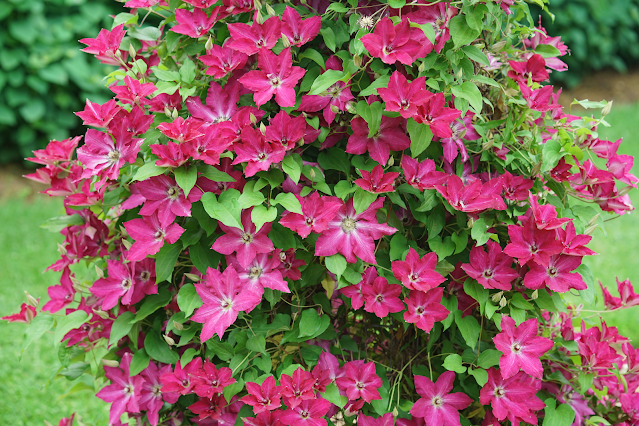

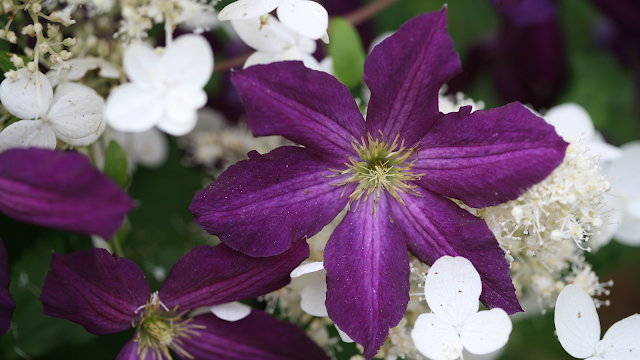
Puffer Fish™ Hydrangea paniculata
Puffer Fish™ hydrangea is a new selection developed at North Carolina State University that will be at retail in a year or so. Think of it as a super-sized Bobo hydrangea. Just like Bobo, it has full, lacy blooms from top to bottom, but the blooms are much bigger. The flowers open pure white and remain white until they transition in fall to a light green. It’s also quite distinct in that new flowers continue to produce at the tip of the panicle, making it looks as if the puffer fish flowers are spitting a bit of water. Puffer Fish has been a standout in all our trials.


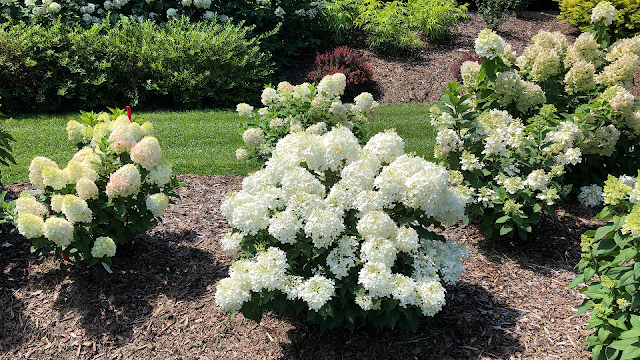
Wine & Spirits™ Weigela
We evaluate a lot of Weigela breeding each year and one of plants that shinned was Wine & Spirits™ weigela, a new variety developed by Megan Mathey. What I love about this selection is its fresh greenish-white flowers. I’ve never seen this color before and it just makes the flowers almost glow against the backdrop of its dark foliage. Growers and retailers will appreciate how well it looks in a container in the spring, and gardeners and landscapers will love how it looks in the landscape. Its unique flower color and overall flower power made it a standout in all of our trials.



Mr. Mustard™ Sorbaria
When we trial a new variety, we compare it to similar plants on the market, and if it’s not better we pass on the plant. Mr. Mustard™ Sorbaria sorbifolia was clearly brighter and more compact than ‘Sem’ and the others. The plant is at its best in spring when it is flushing, showing off its feathered hues of red and yellow. While other selections burn or get ragged by mid-summer, Mr. Mustard Sorbaria passes inspection with its clean green foliage and cherry-red fruit. Be aware this species sends out runners in loamy soils and should only be planted in areas where it is contained. Plant in a isolated bed, or keep it contained by growing it in a decorative container. It’s plenty hardy and will overwinter just fine. Its white, conical, summer blooms look a bit like Astilbe and are wonderful for attracting pollinators. This is a tough, hardy plant that performs wonderfully when in the right location.



Sting™ Thuja occidentalis
I am partial to columnar plants, so it is no wonder that Sting arborvitae captured my heart and imagination. This seedling selection of ‘DeGroot Spire’ that I sowed out some 15-18 years ago has remained exceedingly slim and attractive. Hardy and heat tolerant, use it as an exclamation point, or go all in and plant it in rows down each side of a road, like the Italians do with their narrow Mediterranean cypress, Cupressus sempervirens. Sting Thuja is a fun tree that is only limited by your imagination.


Double Play Spirea: More Than Just Pretty Flowers
As a general rule, Spiraea is known as a hardy, adaptable and attractive ornamental shrub. And of the 90 different Spiraea species, few are as colorful and useful as Spiraea japonica. The species is very hardy, adaptable and offers a wide range of flower and foliage colors. Add to this the ability to cross with other species and you have an array of breeding opportunities. With Spiraea, as well as other species, observation and imagination are the first steps in plant breeding, so looking for and noticing things that others may miss, brings new opportunities.
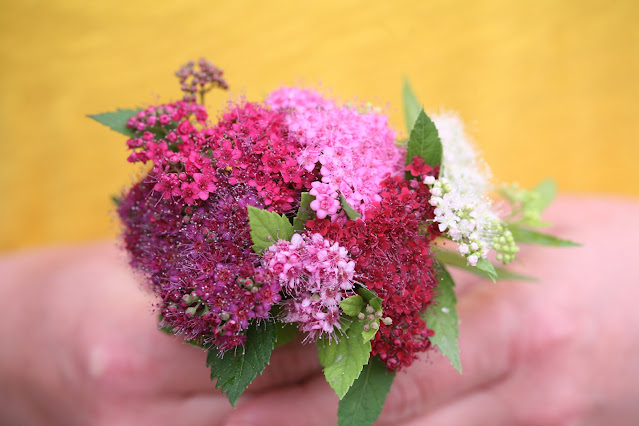
One of our early discoveries was a rich, pink flowered Spiraea fritschiana that we named Pink Parasols® (‘Wilma’). Known for its excellent hardiness and attractive autumn foliage, Spiraea fritschiana is a low mounded, Korean native, with large, attractive blooms that are normally pure white. By pure luck I found this pink flowered anomaly in a batch of seedlings at a local university. The seed source of this plant originated in Korea and I suspect it might have been an accidental hybrid with Spiraea japonica. Pink Parasols is a low mounded plant that is much wider than it is tall, making it an excellent commercial landscape plant.
Another observation we made early on was that most spirea are sold in the spring, well before the flowers appear. This means that the color, texture and health of the foliage is how most consumers judge the plants they are buying. Further observation revealed that some seedlings had especially good, colorful foliage when leafing out in the spring. Such was the case when we crossed Pink Parasols Spiraea fritschiana with a yellow leafed Spiraea japonica variety and came up with a number of unique, colorful hybrids. After evaluating the top selections, we introduced one and named it Double Play Big Bang® (Spiraea x ‘Tracy’). The spring flush of foliage is a vibrant orange. As the foliage matures it turns bright yellow with contrasting red new growth. The pink flowers are extra-large, getting this trait from Spiraea fritschiana. The plant cultivar was named in honor of my wife Tracy, and has proven itself to be first class garden and landscape plant. Thank goodness for that, because you don’t want to name a bad plant after your wife!

It is amazing to note the difference in flowering between cultivars as well as seedlings. Some plants only flower in top while others flower from top to bottom. The corymb (bloom) diameter varies greatly between plants. The green-leafed varieties, Double Play Pink (Spiraea j. ‘SMNSJMFP’) and Double Play Artisan® (Spiraea j. ‘Galen’) were all selected for large corymbs and bloom density from top to bottom having pink and purple flowers respectively. Both cultivars are especially attractive in early spring as the new foliage emerges burgundy-red.

Double Play Red® (Spiraea j. ‘SMNSJMFR’) has beautiful cherry-red spring foliage, but is was primarily selected for its uniquely colored, sangria-red flowers. It is the truest red I have ever seen in a Spirea; better than ‘Dart’s Red’, and far better than ‘Anthony Waterer’. As the flowers age, the dark red hues do transition to pink, so there are times when the flowers will look more pink than red. Regardless, it is a truly unique and beautiful plant.

Many gold-leaved cultivars being grown in the nursery trade are susceptible to powdery mildew (Podosphaera spiraeae). Double Play® Gold was introduced as a solution to this problem. Double Play Gold (Spiraea j. ‘Yan’) is a compact, dwarf, gold foliaged plant adorned with bright, bubblegum pink flowers.
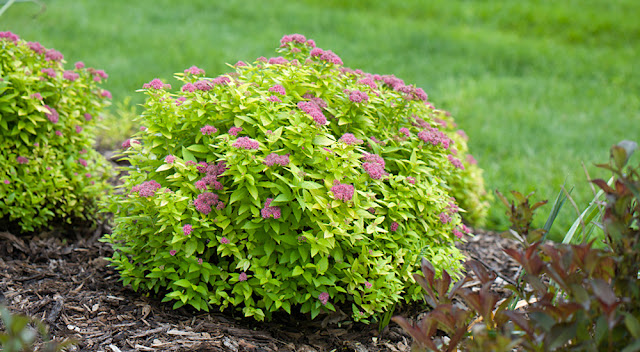
While most of the plants in the Double Play series were developed by Spring Meadow in our internal breeding program, two varieties were developed by North Carolina State University. A number of years ago, we had funded Dr. Thomas Ranney’s plant breeding team to develop sterile cultivars of potentially invasive plants.
One of the common methods for sterile varieties is to create a triploid (3x) plant which has three sets of chromosomes instead of the normal two, a diploid (2x). This was the technique used to create seedless watermelons. The process starts by treating young seedlings with colchicine or oryzalin, which doubles the chromosomes, thus creating a tetraploid (4x) plant. The tetraploid plant is then crossed back with a normal diploid plant. The resulting triploid seedlings are often seedless. Double Play Doozie® (Spiraea japonica ‘NCSX2’) is a seedless triploid, as well as a wide cross containing genes of more than one species. One of the added benefits of seedless plants is that they put their energy into flowering instead of setting seed. With Double Play Doozie Spiraea, this results in a spirea that flowers all summer long.

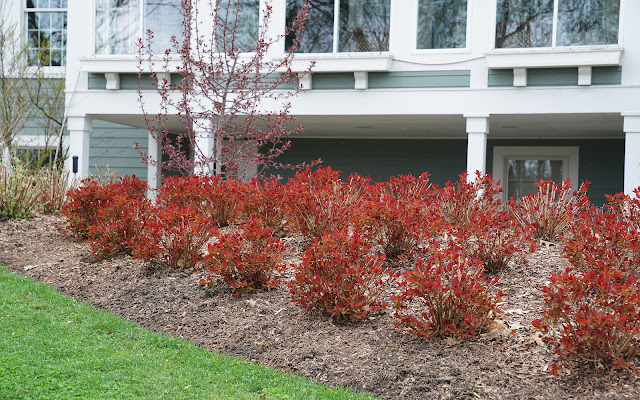
This plant is a game changer in the landscape market because it is so easy to grow and because it looks just as good in flower in August as it does in June when it first flowers. There is no need to shear it to get it to rebloom. The new growth continues to produce flower buds and flowers that cover and hid the older flower heads. The flowers are a vivid dark pink making it the perfect plant to replace ‘Anthony Waterer’ a variety that should have been discontinued year ago because it is a virus infected cultivar.
Double Play Candy Corn® (Spiraea japonica ‘NCSX1’), is another Tom Ranney triploid hybrid, but it is not noted for being a rebloomer. This plant variety was selected for its unique colorful foliage. In the spring the first flush of foliage emerges a fiery orange-red. As spring progresses, the foliage color changes to a bright yellow and then eventually to a butter yellow, while constantly being accentuated with bright reddish-orange hues in the new growth. The color combination is quite unique and pleasing. The name Candy Corn, pays tribute to a sickeningly sweet, American, Halloween candy noted for its bright orange and yellow colors.

There is one more spirea in the Double Play series that is not a Spiraea japonica, but rather a selection of Spiraea media, a species that is native to Eastern Europe. A number of years back we use to grow and sell a Darthauzer nurseries variety named Snowstorm™ (Spiraea media ‘Darsnorm’). After three or four generations of inbreeding and selection we singled out a dwarf plant with notable blue foliage. We introduced it with the name Double Play Blue Kazoo (Spiraea media ‘SMSMBK’) a silly, but memorable name based on the silly children’s musical instrument. I love plants with colorful foliage and especially blue foliage and I believe this is a special plant. It is a low mounded, beauty with waxy, blue-green foliage that is randomly air-brushed with a cast of purple hues. The large, white, spring blooms contrast wonderfully with the richly colored foliage. Like all spirea, it looks best when planted en masse.


It is a bit humorous looking back, because so many people told us we were wasting our time breeding Spiraea. They said, “Who needs another spirea?” But like all plant breeding, there is always room for new plants, if they are improvements. Growers continue to look for plants that finish faster and that have fewer production inputs. Retailers, with a limited number of salespeople, are looking for plants with greater impulse appeal, which will sell themselves. Consumers want shrubs that offer more than just two weeks of flowers. They are looking for reliable plants that earn their keep all season long and these new spirea do just that.
Taming Invasive Species
It is welcome news that lawmakers and the public now recognize the threat of certain exotic species which can displace our native species and alter our native ecosystems. Gardeners, nurserymen, landscaper architects and other land stewards need to act responsively to preserve our native habitats. No one wants to be responsible for the next purple loosestrife, kudzu, or multiflora rose, all well known examples of problematic species. The proverbial Pandora’s box has been opened, and now the question is how to close it.
Lawmakers have been scrambling to solve the problem of invasive plants. Banning plants “deemed invasive” has been the main tool utilized thus far. For example, the Ohio Department of Agriculture has just banned 38 plant species of plants. Banning these weedy, seedy plants should please environmentalists and gardeners alike because most have no commercial or ornamental value. But how do we address address plants that do have horticultural value?
Plant scientists, horticulturists, farmers and gardeners have been breeding and selecting cultivars since the dawn of agriculture. Historically, cultivars have been developed to produce greater crop yields, larger fruit and bigger, more colorful flowers. But they have also developed breeding techniques to create seedless plants. We’re all familiar seedless oranges, seedless watermelons and seedless bananas. So why not create seedless ornamental plants to solve the invasive plant problems? Researcher are!
North Carolina State University researcher have been at the forefront of taming invasive species. Dr. Dennis Werner developed the Lo & Behold® series of butterfly bush (Buddleia) which was granted an exemption in Oregon where Buddleia has been banned because of its evasiveness in the Pacific Northwest.

Dr. Thomas Ranney, another plant researcher at NSCU, has developed two seedless cultivars of Japanese barberry (Berberis thunbergii). One of the cultivars, Sunjoy® Mini Maroon produces fruit, but just like navel oranges the fruit contains no seed. Sunjoy® Toto, another dwarf, dark leafed selection does not produce any fruit at all. Both Sunjoy® Mini Maroon and Sunjoy® Toto perfect replacements for the purple cultivars of barberry that have been shown to be invasive in the Northeastern United States.


Comparison of female fertility traits among cultivars of Berberis.
| Cultivar | n | Fruit Set (%) | Seeds/ Fruit | Germination (%) | Seedlings/ Flower | Relative fertilityZ (%) |
| Sunjoy Mini Maroon‘NCBT1’ | 10 | 0.3 B | 0.10 B | 0.0 B | 0.0 B | 0.0 B |
| Sunjoy Toto ‘NCBX1’ | 5 | 0.0 B | 0.00 B | 0.0 B | 0.0 B | 0.0 B |
| ‘Golden Devine’ | 5 | 33.8 A | 1.15 A | 38.3 A | 0.16 A | 71.3 A |
| ‘Emerald Carousel’ | 8 | 42.7 A | 1.26 A | 41.1 A | 0.22 A | 100.0 A |
| 2014 | ||||||
| ‘NCBT1’ Sunjoy Mini Maroon | 10 | 37.4 B | 0.09 B | 23.3 B | 0.003 B | 1.2 B |
| ‘Golden Devine’ | 4 | 66.0 A | 1.30 A | 30.3 B | 0.284 A | 100.0 A |
| ‘Emerald Carousel’ | 8 | 33.5 B | 1.13 A | 56.4 A | 0.220 A | 77.6 A |
ZRelative fertility = seedlings/flower of that cultivar divided by seedlings/flower for the highest cultivar measured that year x 100. Means followed by the same letter, within a column, for a given year, are not significantly different, P<0 .05=”” a=”” anova=”” based=”” font=”” means=”” on=”” separation.=”” waller-duncan=””>
Cultivars such as these have the potential to, in part, solve the invasive plant problem, but in some cases states are banning them along with the culprit species. It’s frustrating because plant breeders are addressing this issue and their work is going to waste because people are simply uneducated. Legislators are throwing the baby out with the bathwater.
At the moment few people seem to care about the cultivar issue because they don’t know that environmentally safe, seedless cultivars exist. Gardeners, like environmentalists, are proud of our natural heritage and want to preserve native habitats. They want to do what is morally right, but they also want to create beautiful gardens in our man made habitats. Cities and suburbs present challenging growing environments and some plants perform better than our native plants.
There are others who do know about non-invasive cultivars and are content to keep quiet because they’re not gardeners and they don’t want to complicate the invasive plant issue. Their goal is to keep the process moving. And the process is moving fast. The question is “will gardening public wake up and smell the roses?” Perhaps, but it may be too late to make a difference, as states continue to ban environmentally friendly cultivars.
Gardeners and growers are not the bad guys and they need not be the losers. Non-invasive, seedless cultivars are the answer and not the problem in the complex issue of invasive species.
